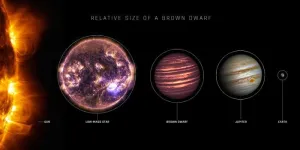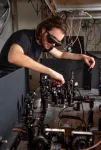(Press-News.org) Astronomers at the University of Sydney have shown that a small, faint star is the coldest on record to produce emission at radio wavelength.
The ‘ultracool brown dwarf’ examined in the study is a ball of gas simmering at about 425 degrees centigrade – cooler than a typical campfire – without burning nuclear fuel.
By contrast, the surface temperature of the Sun, a nuclear inferno, is about 5600 degrees.
While not the coldest star ever found, it is the coolest so far analysed using radio astronomy. The findings are published today in The Astrophysical Journal.
Lead author and PhD student in the School of Physics, Kovi Rose, said: “It’s very rare to find ultracool brown dwarf stars like this producing radio emission. That’s because their dynamics do not usually produce the magnetic fields that generate radio emissions detectable from Earth.
“Finding this brown dwarf producing radio waves at such a low temperature is a neat discovery.”
“Deepening our knowledge of ultracool brown dwarfs like this one will help us understand the evolution of stars, including how they generate magnetic fields.”
How the internal dynamics of brown dwarfs sometimes produce radio waves is something of an open question. While astronomers have a good idea how larger ‘main sequence’ stars like the Sun generate magnetic fields and radio emissions, it is still not fully known why fewer than 10 percent of brown dwarf stars produce such emission.
The rapid rotation of ultracool dwarfs is thought to play a part in generating their strong magnetic fields. When the magnetic field rotates at a different speed to the dwarf’s ionised atmosphere, it can create electrical current flows.
In this instance, it is thought the radio waves are being produced by the inflow of electrons to the magnetic polar region of the star, which, coupled with the rotation of the brown dwarf star, is producing regularly repeating radio bursts.
Brown dwarf stars, so called as they give off little energy or light, are not massive enough to ignite the nuclear fusion associated with other stars like our Sun.
Mr Rose said: “These stars are a kind of missing link between the smallest stars that burn hydrogen in nuclear reactions and the largest gas giant planets, like Jupiter.
The star, with the catchy name T8 Dwarf WISE J062309.94−045624.6, is located about 37 light years from Earth. It was discovered in 2011 by astronomers at Caltech in the United States.
The star’s radius is between 0.65 and 0.95 that of Jupiter. Its mass is not well understood but is at least four times more massive than Jupiter but no more than 44 times more massive. The Sun is 1000 times more massive than Jupiter.
The analysis of the star was made by Mr Rose using new data from the CSIRO ASKAP telescope in Western Australia and followed up with observations from the Australia Telescope Compact Array near Narrabri in NSW and the MeerKAT telescope in South Africa.
Professor Tara Murphy, co-author and Head of the School of Physics at the University of Sydney, said: “We've just started full operations with ASKAP and we're already finding a lot of interesting and unusual astronomical objects, like this.
“As we open this window on the radio sky, we will improve our understanding of the stars around us, and the potential habitability of exoplanet systems they host.”
DOWNLOAD photos at this link.
INTERVIEWS
Kovi Rose | kovi.rose@sydney.edu.au || Prof Tara Murphy | tara.murphy@sydney.edu.au
MEDIA ENQUIRIES Marcus Strom | +61 423 982 485 | marcus.strom@sydney.edu.au
DECLARATION Researchers declare no conflicts.
ACKNOWLEDGEMENTS
The MeerKAT telescope is operated by the South African Radio Astronomy Observatory, which is a facility of the National Research Foundation, an agency of the Department of Science and Innovation. CSIRO’s ASKAP radio telescope is part of the Australia Telescope National Facility (ATNF). Operation of ASKAP is funded by the Australian Government with support from the National Collaborative Research Infrastructure Strategy. ASKAP uses the resources of the Pawsey Supercomputing Research Centre. Establishment of ASKAP, Inyarrimanha Ilgari Bundara, the CSIRO Murchison Radio-astronomy Observatory and the Pawsey Supercomputing Research Centre are initiatives of the Australian Government, with support from the Government of Western Australia and the Science and Industry Endowment Fund. The Australia Telescope Compact Array is part of the ATNF which is funded by the Australian Government for operation as a National Facility managed by CSIRO. We acknowledge the Gomeroi people as the Traditional Owners of the Observatory site. This publication makes use of data products from the Wide-field Infrared Survey Explorer (WISE), which is a joint project of the University of California, Los Angeles, and the Jet Propulsion Laboratory/California Institute of Technology, funded by the National Aeronautics and Space Administration.
END
Astronomers identify the coldest star yet that emits radio waves
Cooler than a campfire and smaller than Jupiter, this brown dwarf star is a rare find
2023-07-13
ELSE PRESS RELEASES FROM THIS DATE:
UT Health Science Center San Antonio develops tool that counts brain lesions in seconds
2023-07-13
SAN ANTONIO (July 13, 2023) — An artificial intelligence (AI) tool developed at The University of Texas Health Science Center at San Antonio accurately counts brain lesions on MRI scans within seconds. Once it is adapted to the clinic, the AI tool should help neuroradiologists to evaluate patients’ brain diseases at earlier stages.
“Certain kinds of brain lesions are tremendously difficult to quantify without AI,” said researcher Mohamad Habes, PhD, of the health science center’s Glenn Biggs Institute for Alzheimer’s and Neurodegenerative ...
New ways of getting to the heart of the matter
2023-07-13
Peter Keyel, an associate professor in Texas Tech University’s Department of Biological Sciences, has received an Innovative Project Award from the American Heart Association to study atherosclerosis, the condition that causes arteries to thicken and can trigger a variety of devastating health complications.
Statistics indicate diseases linked to atherosclerosis are the leading cause of death in the U.S. with as many as half of Americans between the ages of 45 and 84 having the condition but being unaware of its slow progression and ...
Researchers establish criterion for nonlocal quantum behavior in networks
2023-07-13
A new theoretical study provides a framework for understanding nonlocality, a feature that quantum networks must possess to perform operations inaccessible to standard communications technology. By clarifying the concept, researchers determined the conditions necessary to create systems with strong, quantum correlations.
The study, published in Physical Review Letters, adapts techniques from quantum computing theory to create a new classification scheme for quantum nonlocality. This not only allowed the researchers to unify ...
Youth of color turn to TikTok for diet, fitness information
2023-07-13
FOR IMMEDIATE RELEASE
Thursday, July 13, 2023
Contact:
Jillian McKoy, jpmckoy@bu.edu
Michael Saunders, msaunder@bu.edu
##
Youth of Color Turn to TikTok for Diet, Fitness Information
A new study found that social media platforms, particularly TikTok and Instagram, are ideal spaces to educate and guide US youth of color on healthy weight management and ultimately reduce racial inequities in obesity.
Nearly 1 in 4 adolescents in the United States experienced obesity from 2017 to ...
Controlling quantum randomness from the vacuum
2023-07-13
A team of researchers from the Massachusetts Institute of Technology has achieved a milestone in quantum technologies, demonstrating for the first time the control of quantum randomness.
The team of researchers focused on a unique feature of quantum physics known as "vacuum fluctuations". You might think of a vacuum as a completely empty space without matter or light. However, ...
Building a better forest tree with CRISPR gene editing
2023-07-13
Researchers at North Carolina State University used a CRISPR gene-editing system to breed poplar trees with reduced levels of lignin, the major barrier to sustainable production of wood fibers, while improving their wood properties. The findings – published in the journal Science – hold promise to make fiber production for everything from paper to diapers greener, cheaper and more efficient.
Led by NC State CRISPR pioneer Rodolphe Barrangou and tree geneticist Jack Wang, a team of researchers used predictive modeling to set goals of lowering lignin levels, increasing the carbohydrate to lignin (C/L) ratio, and increasing the ratio of two important ...
Special Issue: A machine-intelligent world
2023-07-13
In this special issue of Science, nine pieces – including Perspectives, Policy Forums, and Reviews – highlight recent advancements in artificial intelligence (AI) technologies and how they’re being used to answer novel questions in topics ranging from human health to animal behavior. However, the recent widespread adoption of AI in these areas is not without unique ethical concerns and policy challenges. “By looking to the forefront of how AI is being used in science and society, many grand challenges and benefits appear,” writes Gemma Alderton, deputy editor at Science.
AI-predicted ...
Genetic editing of wood for sustainability
2023-07-13
Despite the importance of wood fibers to meet the growing demand for renewable tissue, paper, packaging, textile, and other fiber products, wood fiber production has been less efficient and productive than researchers have hoped. Now, CRISPR editing has enabled scientists to design wood in which lignin – which must be cleaved and dissolved so fiber production can take place – is more suitable for fiber production. “The edited wood alleviates a major fiber-production bottleneck … and could bring unprecedented operational efficiencies, bioeconomic ...
Use of ChatGPT improves productivity, with particular benefits to those with weaker skills
2023-07-13
The use of ChatGPT – a chatbot that can generate human-like text – raises productivity in professional writing tasks and reduces productivity inequality in those who use it, according to a new study involving over 400 college-educated professionals. Although the findings reveal direct and immediate effects of ChatGPT on worker productivity, study authors Shakked Noy and Whitney Zhang note that longer-term impacts on complex labor market dynamics, which will likely arise as firms and workers adapt to ChatGPT, remain unknown. “Overall, the arrival of ChatGPT ushers ...
Chagas Disease is also underdiagnosed in Spain
2023-07-13
A high percentage of people from Latin America are infected with the parasite that causes Chagas disease. This is the conclusion of an analysis of nearly 3,000 people from countries where the disease is endemic and who attended the International Health Service at Barcelona’s Hospital Clinic, over a 17-year period. The study, published in PLOS Neglected Tropical Diseases, was led by the Barcelona Institute for Global Health (ISGlobal), an institution supported by "la Caixa" Foundation.
Nearly 7 million people in the world are estimated to be infected ...
LAST 30 PRESS RELEASES:
Groundbreaking discovery turns household plastic recycling into anti-cancer medication
Blocking a key inflammatory pathway improves liver structure and vascular function in cirrhosis, study finds
Continuous spread: Raccoon roundworm detected in nine European countries
HKUST Engineering researchers developed a novel photodetector to enhance the performance of on-chip light monitoring
Strategic river sensors could have forewarned of Texas Camp flood disaster
Drone sampling of whale breath reveals first evidence of potentially deadly virus in Arctic
Roman soldiers defending Hadrian’s Wall infected by parasites, study finds
Pinochet’s prisoners were tormented with music but still found solace in it, a new book reveals
Fertility remains high in rural Tanzania despite access to family planning
AI-assisted device can improve autism care access
Kinetic careers
Uncovering how parasitic plants avoid attacking themselves to improve crop resistance
Nanoparticle vaccine strategy could protect against Ebola and other deadly filoviruses
Study finds brain care score can predict risk of stroke across racial groups
Key lung immune cells can intensify allergic reactions
Do hormones explain why women experience more gut pain?
New materials conduct ions in solids as easily as in liquids
Breakthrough of the Year: Renewable energy begins to eclipse fossil fuel-based sources
LLM use is reshaping scientific enterprise by increasing output, reducing quality and more
Introducing LightGen, a chip for ultra-fast, ultra-efficient generative AI
Astronomers see fireworks from violent collisions around nearby star
ACC/AHA issue new guideline on managing congenital heart disease in adults
Cosmic crash caught on camera
Is talented youth nurtured the wrong way? New study shows: top performers develop differently than assumed
Ants: An untapped resource in the development of antibiotics?
Archaeologists use AI to create prehistoric video game
Mitochondria migrate toward the cell membrane in response to high glucose levels
Tiny viral switch offers hope against drug-resistant bacteria
Most parents aware of early peanut introduction guidelines, but confused about details
HPV vaccine can protect against severe lesions of the vulva and vagina
[Press-News.org] Astronomers identify the coldest star yet that emits radio wavesCooler than a campfire and smaller than Jupiter, this brown dwarf star is a rare find






